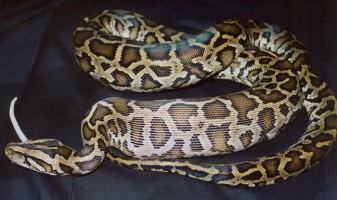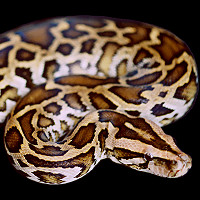| |

Comparative
Muscle Physiology
I am generally interested in the physiology of vertebrate
skeletal and cardiac muscle, and in particular, the myosin heavy-chain
contractile protein. Myosin is the major force producing component
of muscle, and has many functionally different isoforms; each protein
is a distinct gene product and is differentially expressed in individual
muscles. The control of myosin protein expression is complex, and
is very sensitive to activity, temperature, and hormone influences.
Skeletal muscle and the heart are both affected by exercise, resistance
training, and other factors, which may dramatically change the muscle
size and myosin heavy chain composition. I am most interested in
shifts or transitions in myosin protein expression with increased
activity, or conversely, with disuse.
As a proponent of the comparative approach, my laboratory
investigates a wide variety of vertebrates, each of whom demonstrates
some remarkable aspect of muscle physiology. The techniques involved
are elementary to muscle physiology and molecular biology, but are
somewhat novel in their application to these diverse organisms.
Protein gel electrophoresis is useful for measuring the expression
of myosin isoforms in individual muscles, or even individual muscle
fibers. Reverse-transcriptase polymerase chain reaction (RT-PCR)
allows estimation of the mRNA expression of each myosin gene, and
in general, myosin genes from new species are sequenced where possible.

Hibernating Mammals
Hibernating mammals present many interesting opportunities
to study muscle biology. Many mammals, from orders as diverse as
rodents, bats, bears, and even primates, spend months in a state
of lowered metabolism and reduced physical activity. In the few
instances where it has been investigated, the muscles of these hibernators
demonstrate the remarkable ability to withstand disuse atrophy and
a loss of oxidative metabolism. I have studied this in golden-mantled
ground squirrels, two species of prairie dogs, and black bears,
using SDS-PAGE, and after cloning the myosin genes, RT-PCR. Myosin
expression is altered following up to 6 months of inactivity, but
in the direction of more oxidative, fatigue-resistant isoforms,
uncharacteristic of disuse in non-hibernators. My lab continues
to work on the possible transcriptional control and environmental
factors that influence hibernating muscle phenotypes.
Snake
Cardiovascular Response to SDA
 An
increase in postprandial metabolism has been well documented in
carnivorous lizards and snakes. Pythons were reported to undergo
a rapid upregulation of many tissues, including an enlargement of
the heart, to support the increased metabolic demands. With collaborators
James Hicks, Albert Bennett and Johnnie Andersen at UC Irvine, we
have recently demonstrated a remarkable 40% hypertrophy of the python
ventricle within two days of consuming a large meal (25% of body
mass). We are now examining the possible hormonal triggers to this
hypertrophy, and continue to characterize the cardiovascular contribution
to the metabolic response. We have sequenced the myosin genes from
the heart of Python molurus, and are using molecular techniques
to examine the response of other tissues as well. An
increase in postprandial metabolism has been well documented in
carnivorous lizards and snakes. Pythons were reported to undergo
a rapid upregulation of many tissues, including an enlargement of
the heart, to support the increased metabolic demands. With collaborators
James Hicks, Albert Bennett and Johnnie Andersen at UC Irvine, we
have recently demonstrated a remarkable 40% hypertrophy of the python
ventricle within two days of consuming a large meal (25% of body
mass). We are now examining the possible hormonal triggers to this
hypertrophy, and continue to characterize the cardiovascular contribution
to the metabolic response. We have sequenced the myosin genes from
the heart of Python molurus, and are using molecular techniques
to examine the response of other tissues as well.
Reptile
Exercise and Muscle Response
In mammals, increased aerobic exercise generally causes
an enlargement of skeletal muscle, and an increased accumulation
of type I or type IIa myosin heavy chain. Reptiles, such as the
carnivorous Varanus exanthematicus, may go several months
without activity during the dry season, and yet may suffer no disuse
atrophy of skeletal muscle. With Amanda Szucsik at UC Irvine, we
are looking at how exercise and immobilization affect the myosin
isoform protein and mRNA expression in the relatively aerobic Varanus
species.
Myosin
Evolutionary Genetics
 As
we accumulate more myosin sequences from skeletal and cardiac muscle
of a variety of vertebrates, we are examining the evolutionary genetics
of myosin as the new groups are cloned. New sequences are used to
develop PCR primers to measure mRNA expression of the isoforms,
and to analyze patterns of sequence divergence. This is now expanding
into marine organisms for which little sequence information is available,
including elasmobranch fishes and additional teleost species. As
we accumulate more myosin sequences from skeletal and cardiac muscle
of a variety of vertebrates, we are examining the evolutionary genetics
of myosin as the new groups are cloned. New sequences are used to
develop PCR primers to measure mRNA expression of the isoforms,
and to analyze patterns of sequence divergence. This is now expanding
into marine organisms for which little sequence information is available,
including elasmobranch fishes and additional teleost species.
|
|





 An
increase in postprandial metabolism has been well documented in
carnivorous lizards and snakes. Pythons were reported to undergo
a rapid upregulation of many tissues, including an enlargement of
the heart, to support the increased metabolic demands. With collaborators
James Hicks, Albert Bennett and Johnnie Andersen at UC Irvine, we
have recently demonstrated a remarkable 40% hypertrophy of the python
ventricle within two days of consuming a large meal (25% of body
mass). We are now examining the possible hormonal triggers to this
hypertrophy, and continue to characterize the cardiovascular contribution
to the metabolic response. We have sequenced the myosin genes from
the heart of Python molurus, and are using molecular techniques
to examine the response of other tissues as well.
An
increase in postprandial metabolism has been well documented in
carnivorous lizards and snakes. Pythons were reported to undergo
a rapid upregulation of many tissues, including an enlargement of
the heart, to support the increased metabolic demands. With collaborators
James Hicks, Albert Bennett and Johnnie Andersen at UC Irvine, we
have recently demonstrated a remarkable 40% hypertrophy of the python
ventricle within two days of consuming a large meal (25% of body
mass). We are now examining the possible hormonal triggers to this
hypertrophy, and continue to characterize the cardiovascular contribution
to the metabolic response. We have sequenced the myosin genes from
the heart of Python molurus, and are using molecular techniques
to examine the response of other tissues as well. As
we accumulate more myosin sequences from skeletal and cardiac muscle
of a variety of vertebrates, we are examining the evolutionary genetics
of myosin as the new groups are cloned. New sequences are used to
develop PCR primers to measure mRNA expression of the isoforms,
and to analyze patterns of sequence divergence. This is now expanding
into marine organisms for which little sequence information is available,
including elasmobranch fishes and additional teleost species.
As
we accumulate more myosin sequences from skeletal and cardiac muscle
of a variety of vertebrates, we are examining the evolutionary genetics
of myosin as the new groups are cloned. New sequences are used to
develop PCR primers to measure mRNA expression of the isoforms,
and to analyze patterns of sequence divergence. This is now expanding
into marine organisms for which little sequence information is available,
including elasmobranch fishes and additional teleost species.